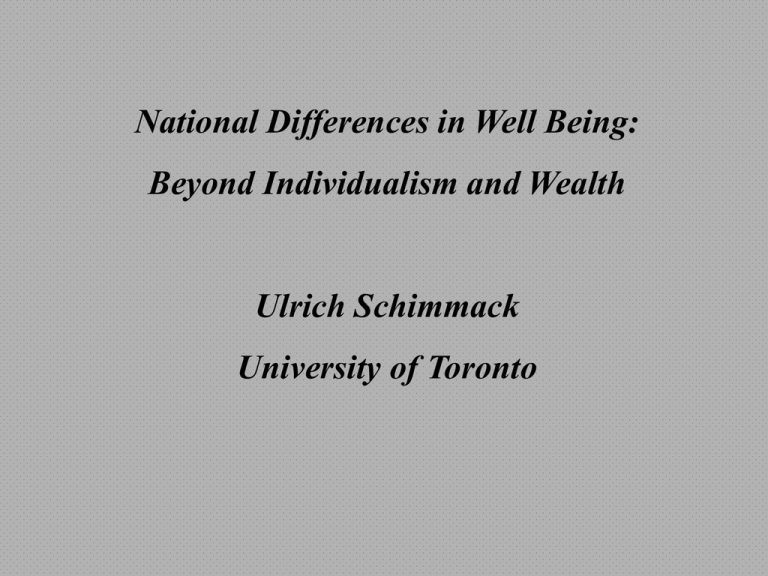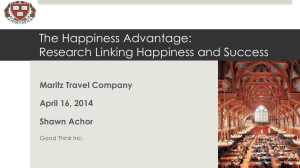Talk HK June 05 National Differences in Happiness
advertisement

National Differences in Well Being: Beyond Individualism and Wealth Ulrich Schimmack University of Toronto Background Over the past 50 years, happiness in various nations has been measured in national representative surveys. Happiness has been assessed by single-item indicators of general happiness or satisfaction. For example: All things considered, how satisfied would you say you are with your life these days? (Average on a scale of one to 10) Source. R. Veenhoven, States of Nations, World Database of Happiness, Internetsite: www2.eur.nl/fsw/research/ happiness (2005) Ruut Veenhooven compiled data from various surveys. The database includes over 1000 data points and has been used by many other researchers to examine determinants of national differences in happiness. Source. R. Veenhoven, States of Nations, World Database of Happiness, Internetsite: www2.eur.nl/fsw/research/ happiness (2005) Reliability • Surveys from different years show high reliability across nations. 1970s – 1980s 1980s – 1990s 1970s – 1990s r = .81 r = .91 r = .71 •Diener and colleagues also obtained an average correlation of r = .71 across three different surveys. •Diener, E., Diener, M. & Diener, C. (1995). Factors predicting the subjective wellbeing of nations. Journal of Personality and Social psychology, 69, 851-864. Comparison of Subgroups within Nations - Similar national differences are obtained for subgroups of populations. - The correlation between men and women from different nations is r = .97. - The mean correlation for different age groups is r = .93. Source. Diener, E., & Suh, E. (1999). National differences in subjective well being. In D. Kahneman, E. Diener, & N. Schwarz, Well-Being: The foundations of hedonic psychology. Nations’ happiness blue = happy; red = unhappy Predictors - One salient difference between happy and unhappy nations is wealth. - National differences in wealth are highly correlated with other indicators of objective well being (longevity, low corruption, human rights, freedom, etc.). - All of these indicators of objective well-being predict national differences in happiness moderately well. Source. Diener, E., Diener, M. & Diener, C. (1995). Factors predicting the subjective well-being of nations. Journal of Personality and Social psychology, 69, 851-864. Relationship of Wealth and Related Indicators with Happiness Study Cantril (1965) Veenhoven (1991) Diener et al. (1995) Schimmack (2005) Correlation .67 .84 .61 .60 Happiness Residuals controlling for Wealth Psychological Variables - In a very influential book, Hofstede (1980) demonstrated cultural differences in individualism. - Individualistic nations emphasis on the rights of individuals, freedom of choice, and independence, whereas collectivistic nations emphasis the importance of groups and conforming to social norms. - The Individualism-collectivism dimension has become the main explanatory construct in cross-cultural psychology. - Individualism is also a predictor of happiness. - However, individualism does not predict unique variance in happiness beyond wealth because Individualism is highly correlated with wealth and related indicators (r > .80). Source. Schimmack, U., Oishi, S., & Diener, E. (2004). Self-Esteem - Self-esteem is a global positive evaluation of oneself. - Studies of individuals show a high correlation between happiness and self-esteem, especially in Western nations. - This finding raises three questions: - 1. Do nations differ in self-esteem? - 2. Do national differences in self-esteem predict happiness? - 3. Does self-esteem make a unique contribution beyond wealth? Data - Michalos’s (1991) international student survey (M-ISS, N = 37 nations) - Diener’s (1996) international student survey (D1-ISS, N = 40 nations) - Diener’s (2002) 2nd international student survey (D2-ISS, N = 48 nations) Self-esteem measure: “I am satisfied with my self.” 1. Are there national differences in self-esteem? M-ISS M-ISS D1-ISS D1-ISS D2-ISS D2-ISS Reliability: alpha(17) = .86 Correlation r(23) = .63 r(26) = .66 r(27) = .53 National Differences in Self-Esteem 2. National differences in Self Esteem and Happiness East Asia East Asia Esteem Esteem Happiness Happiness Correlation r(68) = -.55 r(68) = -.25 r(68) = .34 - National differences in esteem predict happiness. - National differences in esteem account for the lower SWB in East Asian samples. 3. Does Esteem make a unique contribution? Hierarchical regression analyses: 1. Step Wealth .60 2. Step Wealth Esteem .67 .42 1. Step Wealth .60 2. Step Wealth East Asia .63 -.28 R2 .36 .51(.17) R2 .36 .43(.07) Conclusion - National differences in self-reported selfesteem are reliable. - National differences in self-esteem predict national differences in happiness beyond the effect of wealth or individualism. - The contribution of self-esteem to SWB accounts for the low SWB in East Asia (China, HK, Taiwan, South Korea, & Japan). Theoretical Explanations 1. Genetic differences between ethnic groups. 2. Cultural differences in self-enhancement. 3. Cultural differences in criticism. 4. Cultural differences in dialectic thinking. 5. Cultural differences in ideals. 6. Modesty effects on self-report data (artifact) Genetic Hypothesis “It is possible that genetic differences between ethnic groups might explain differences in SWB [subjective well being ~ happiness]” (Diener & Suh, 1999, p. 448) The genetic hypothesis can be tested relatively easily by examining acculturation effects of immigrants that move from East Asia to North America. Acculturation Effects - Heine et al. (1999) observed higher self-esteem for Asian Canadians compared to a Japanese sample in Japan. - Chan, Yiu Man (2000) observed higher selfesteem in Chinese immigrant children in the UK than in Chinese children in HK. - These findings suggest that low self-esteem in Asia is not due to genetic differences between ethnic groups. Self-Enhancement - Self-enhancement is defined as overly positive views of the self. One form of self-enhancement is a self-serving bias in attributions of successes and failures. - A meta-analysis revealed a lack of self-serving attributions in Japan, but equally strong selfserving biases in South Korea and China as in North America (Mezulis, Abramson, Hyde, & Hankin, 2004). - Lack of self-enhancement does not seem to account for low self-esteem in East Asia. Criticism - Kitayama, Karasawa, et al. (1999) found that Japanese received more criticisms than North Americans. - Solid evidence regarding cultural differences in criticism (or praise) are lacking. - Future research may show that East Asian cultures are more criticism. Cultural Differences in Standards - Heine et al. (1999) discuss the role of perfectionism and constant self-improvement in Japanese culture. - The economic success of East Asian nations compared to Latin American and African cultures also suggests high achievement goals. - However, North America seems to be able to combine high achievement motivation with high self-esteem. Modesty Bias in Self-Report Data - Kurman (2003) found correlations between a modesty scale (I am embarrassed to talk about my positive qualities) and reports of selfesteem and happiness. - Non self-report measures (preference for initials, IAT) do not show lower self-esteem in East Asian samples (Kitayama & Greenwald, 2003). - Modestly is a viable explanation for the findings. General Conclusion - National differences in self-esteem are reliable and predict happiness beyond wealth or individualism. - The low self-esteem in East Asia explains why East Asian nations are less happy than predicted by wealth. - Future research needs to uncover the cultural factors that produce national differences in self-esteem.







